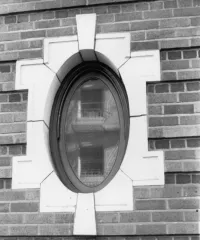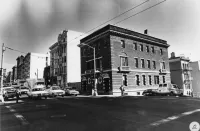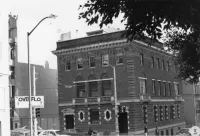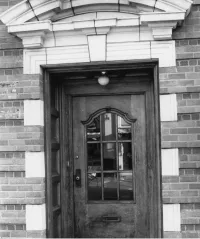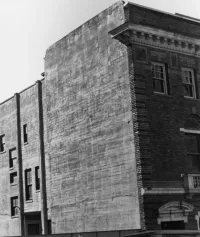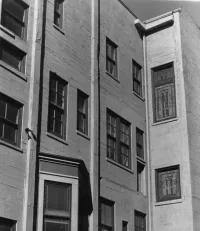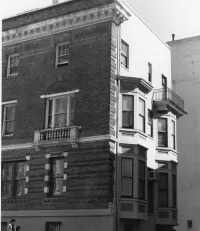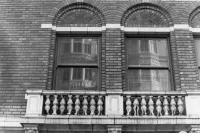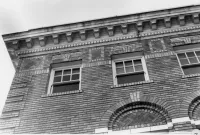Share what you know,
and discover more.
Share what you know,
and discover more.
Aug 15, 1985
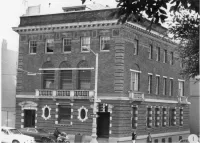
-

- Charmaine Bantugan
Dr. Martin M. Krotoszyner Medical Offices and House - National Register of Historic Places
Statement of Significance: Based upon the summary and subsequent information in the-preening Description section, there can be no question that 995-999 Sutter "possesses integrity of location, design, setting, material, workmanship, feeling and association". The Krotoszyner residence and medical office building is also significant in that it housed Doctor Martin Krotoszyner, "pioneer cystoscopies and blood cryoscopies" who "was recognized as the most erudite urologist in the West", and who 'trained many of the best known urologists in San Francisco" according to re known medical historian Miley Barton Wesson, (Criteria B), With respect to Criteria C, the building is an excellent example of the City Beautiful/Beaux Arts Classicism in which the city of San Francisco was clothed during the massive rebuilding which followed the 1906 earthquake and fire. As an individual building, the Krotoszyner office/residence represents a skillful manipulation of the elements of its style. It contains elegantly proportioned facade elements, particularly along the Sutter Street elevation; well-executed ornamental details; some unusual decorative components; and its richly mottled brick surfacing is exceptional. As a combination doctor’s office and residence, the building is an Increasingly rare survival of an unusual Tenderloin area building type; only two other such types are knovja to remain, and both are of substantially less architectural and historic Interest than the Krotoszyner building. Architect Herman Barth, while not a designer of the very first rank, was a figure of some significance in his own time, and his buildings continue to be judged as Important components of San Francisco’s architectural heritage. Herman Barth was born in Germany in 1865, He first appears in the San Francisco City Directory in 1882 as a draftsman with Kenitzer and Raun. From 1894 - 1899, he was in partnership with Charles W, Kenitzer, to when he was apparently related by marriage. From 1899 until his death in 1923, he was in practice without a partner. artner. His published work reveals a wide range of building types: residential, commercial and institutional. Among the more specialized examples are a mausoleum at the smaller end of the architectural scale, and hospital construction at the larger end. One of his hospital designs was the German (later Franklin) Hospital, where Doctor Krotoszyner was chief urologist from 1904 - 1918. Barth was also responsible for the Alameda Hospital, and the Tuberculosis Unit of San Francisco City Hospital, the commission for the latter was won in an invitational competition organized and supervised by three of the Bay Area’s major architects: John Galen Howard; Frederick Meyer; and John Reid, Jr, the competition was juried by C, S, Kaiser and Julia Morgan. That Barth was invited to participate in such a prestigious competition indicates considerable standing in the architectural community. Barth's obituary in the California Architect and Engineer noted his addition to San Francisco City Hospital was "one of his best works". Another of Barth’s buildings, the Young Building on Market Street, was cited in an article in the May 1906 issue of the Architect and Engineer of California dealing with the structural damage caused by the 1906 earthquake for the "admirable condition" with which its concrete structural system survived the tremor. Although gutted by the fire which followed the earthquake, the Young Building was refurbished and continues in use today as a commercial and office structure. The architect/client relationship seems to have been a congenial one as Barth was also the architect of another building project of Krotoszjmer’s. This was a branch Post Office, known as Station 0, located at 1217-1227 Sutter Street which was built to Government specifications in 1910 - 1911 under a long-term lease with Doctor Krotoszyner, Although the building appears to be physically small, it was made memorable by Barth's skill as a designer. Although it is clear that Barth was not as important as Willis Polk, Ernest Coxhead, or Bakewell and Brown, he must be considered a significant figure. He was a member of that group of talented and skillful but lesser-known designers whose work is responsible for the amazingly high quality of San Francisco's contextually significant buildings; and in some of his works such as the Krotoszyner office/ residence, Barth demonstrates his ability to rise considerably above the merely competent. petent. According to authoritative medical historian Miley Barton Wesson in The Early History of Urology on the West Coast" as reprinted from Volume One of his History of Urology, Dr, Krotoszyner was born in Ostrowo, Germany, on September 6, 1861, Proficient in Greek and Latin, he entered the University of Berlin to study philology as preparation for a teaching career. After three semesters, he changed his course of study to medicine. He passed his state examinations at the University of Berlin on July 25, 1887, and received his Doctor of Medicine at the University of Leipzig on August 12 of that same year. Several months later, he responded to an advertisement for a ship's surgeon, and sailed from Hamburg to New York, arriving there on March 12, 1888, soon thereafter, he traveled to Arizona to relieve a young physician who wished to return to Europe for further studies. After six months, it was clear to Doctor Krotoszyner that frontier life was not to his liking, so he departed for Los Angeles which was just as hot as Arizona had been, and therefore, not to his liking. Having relatives in San Francisco, he decided to go there, and arrived in the fall of 1888, within several days, he had found quarters at 43 Sixth Street where he practiced medicine as well. Shortly after joining the California State medical Society in 1892, Doctor Krotoszyner elected to specialize in urology. Possibly because Germany was on the cutting edge in the field, and possibly because he wished to see family and friends again. Doctor Krotoszyner returned to Germany in 1893 for six months of intensive specialized study. Soon after returning to San Francisco, Doctor Krotoszyner presented a paper to the San Francisco Medical Society entitled "The Development and Future of Endoscopy of the Urethra and Bladder", Me concluded that "the cystoscope is for urology of the same revolutionary influence as the ophthalmoscope and laryngoscope have been for ophthalmology and laryngology", (Harris and Mathes), He is credited with bringing the cystoscope to San Francisco and demonstrating its uses in 1894, A subsequent visit to Germany in 1897 introduced him to the diagnostic advantages of ureteral catheterization which he once again demonstrated to his colleagues upon his return. That same year, genitourinary surgery was a prime topic for discussions at the San Francisco Medical Society, Consequently, Doctor Krotoszyner presented a paper entitled "A Case of Nephrectomy for Nephrolithiasis" on September 14th, according to Wesson, in addition to the accolades above. Dr. Krotoszyner was "recognized as a hard student, a prolific writer of truly scientific papers, a perfect consultant, (and) a teacher by disposition and training. Having moved his offices in 1897 to 700 Sutter Street, Doctor Krotoszyner became Chief of Urology at French Hospital in 1899. He remained there until 1904, when he resigned to become chief of the urological department of Franklin Hospital which was known as German Hospital until the outbreak of World War I. It interesting to note that both hospitals grew out of ethnic associations known as benevolent societies which were formed in the 1850*s and were supported by dues paying members. In 1909, Doctor Krotoszyner became chief of urology at the San Francisco Polyclinic in addition to his responsibilities at Franklin Hospital. The San Francisco Polyclinic began as an outgrowth of the medico-social Friday Night (or Evening) Club which was comprised of 12 "well-known practitioners who were not closely affiliated with medical facilities". (Harris). The clinic was founded in 1888, and opened its doors above a livery stable on Ellis Street in 1889. Because many of those associated with it wished to teach, in 1892, the Polyclinic became the Post-Graduate Medical Department of the University of California, an arrangement that was subsequently dissolved to assure the clinic's Independence, the clinic remained a teaching and research facility while treating the City's ambulatory poor until recent years, and it was here that Doctor Krotoszyner "trained many of the best-known urologists in San Francisco" (Wesson) before his death in 1918. Doctor Krotoszyner's other professional affiliations Included the chairmanship of the neurological section of the San Francisco Medical Society in 1911, and the vice-chairmanship of the urological section of the American Medical Association in 1917. In addition to authoring numerous scientific articles that were published nationally and internationally. Doctor Krotoszyner was the American Editor of Professor Nitze's Jahrbuch der Urologle beginning in 1905, and was on the editorial board of Surgery. Gynecology and Obstetrics at the time of his death. (Wesson). In moving his offices first to 700 Sutter Street, and then in 1903, to 1207- 1209 Sutter can be attributed to the high concentration of physicians' offices and pharmacies prior to the 1906 earthquake and fire which devastated the area. Many physicians returned to the area in the years following the disaster. Some of these were undoubtedly encouraged by the circa 1910 relocation and construction of Saint Francis Hospital at Bush and Hyde Streets, a block north of what was to become the Krotoszyner property which Doctor Krotoszyner purchased from Doctor Julius Rosenstirn, a colleague who had owned numerous parcels in the immediate vicinity for many years. Doctor Krotoszyner and his family moved into 995 - 999 Hyde Street in 1911 - 1912, and were living there at the time that he was shot to death in his office on April 20, 1988, by an irate patient, actor Frank Freeman, who immediately shot himself on Hyde Street. Mrs, Krotoszyner and her five children continued to reside in the family home until 1937 - 1938. Doctor Krotoszyner's brother-in-law. Doctor George W, Hartman, maintained his office at 999 Sutter until 1945 when he apparently retired. At that time, the family leased the entire building to Doctor Robert M. Perlman who subsequently purchased the building from the family in August 1950, Doctor Perlman apparently used the entire building for medical purposes to house both his office and the Institute of Endocrinology and Gerontology which later was known as the Institute of Endocrinology and Gerontology. As late as the mld-1950’s. Doctor Perlman also leased space in the building to Doctor George J. Heppner, a radiologist who remained there until 1966, During the early to mid-1960’s, the remainder of the space was leased to the Bay Medical Group, a voluntary pre-paid medical plan, which included an eye clinic and pharmacy. Other tenants included the Bay Health Association, a complete physicians and surgeons medical service, and the Physicians and Surgeons Association, when these organizations vacated the building in 1966, it remained vacant until Doctor Perlman moved his offices back into the building from 1969 until 1980 when he sold the building for law offices. Because of its location on the southeast corner of the intersection of Sutter and Hyde, a. one-way street southbound on a relatively steep slope, the Rrotoszyner building is a visual landmark visible from several blocks away. Its distinctive character is heightened because buildings on other comers of the intersection and nearby tend to be six to eight stories in height, some with commercial uses on the ground level, end are generally sited on standard 25-foot-wide lots. Most of these buildings were constructed circa 1910 or later as apartment houses, and while some are architecturally interesting, or possess notable features, they tend to blend together due, in part, to their verticality, and light-colored building materials or paint. In comparison, the handsomely detailed Krotoszyner Building is rectilinear with a frontage of approximately 37,5 feet on Sutter and 69 feet on Hyde. Because the lot measures 62,5 feet on Sutter and 87,5 feet on Hyde, the building is set off on both sides by open areas of 25 feet and approximately 19 feet respectively. The Krotoszyner Building is included in two of San Francisco's architectural surveys or inventories. In the Department of City Planning's 1976 Architectural Inventory, it received a summary rating of "2" out of a possible ”5’', It is important to note that this inventory was visual only; therefore, the ratings are not based upon historical considerations. However, the building did receive particularly high marks for its setting, its contribution to a cluster or streetscape, and the importance of its cornice to overall building design. The Krotoszyner Building is also included in the Foundation for San Francisco's Architectural Heritage Outer Downtown Survey which was conducted from 1982 to 1984, Because this survey includes historical, and architectural history as well as interior information, the building received a ‘'B" rating, the second highest possible rating. Based upon survey criteria, buildings so rated are eligible for listing in the National Register of Historic Places, of particular note with respect to design are the entrances, the rusticated base, the balconies and the cornice as well as the stained-glass windows on stairway landings. It is further noted that is conspicuous for its design quality, its importance to the streets it faces, and the fact that it is one of very few residential/medical office buildings in the area.
Dr. Martin M. Krotoszyner Medical Offices and House - National Register of Historic Places
Statement of Significance: Based upon the summary and subsequent information in the-preening Description section, there can be no question that 995-999 Sutter "possesses integrity of location, design, setting, material, workmanship, feeling and association". The Krotoszyner residence and medical office building is also significant in that it housed Doctor Martin Krotoszyner, "pioneer cystoscopies and blood cryoscopies" who "was recognized as the most erudite urologist in the West", and who 'trained many of the best known urologists in San Francisco" according to re known medical historian Miley Barton Wesson, (Criteria B), With respect to Criteria C, the building is an excellent example of the City Beautiful/Beaux Arts Classicism in which the city of San Francisco was clothed during the massive rebuilding which followed the 1906 earthquake and fire. As an individual building, the Krotoszyner office/residence represents a skillful manipulation of the elements of its style. It contains elegantly proportioned facade elements, particularly along the Sutter Street elevation; well-executed ornamental details; some unusual decorative components; and its richly mottled brick surfacing is exceptional. As a combination doctor’s office and residence, the building is an Increasingly rare survival of an unusual Tenderloin area building type; only two other such types are knovja to remain, and both are of substantially less architectural and historic Interest than the Krotoszyner building. Architect Herman Barth, while not a designer of the very first rank, was a figure of some significance in his own time, and his buildings continue to be judged as Important components of San Francisco’s architectural heritage. Herman Barth was born in Germany in 1865, He first appears in the San Francisco City Directory in 1882 as a draftsman with Kenitzer and Raun. From 1894 - 1899, he was in partnership with Charles W, Kenitzer, to when he was apparently related by marriage. From 1899 until his death in 1923, he was in practice without a partner. artner. His published work reveals a wide range of building types: residential, commercial and institutional. Among the more specialized examples are a mausoleum at the smaller end of the architectural scale, and hospital construction at the larger end. One of his hospital designs was the German (later Franklin) Hospital, where Doctor Krotoszyner was chief urologist from 1904 - 1918. Barth was also responsible for the Alameda Hospital, and the Tuberculosis Unit of San Francisco City Hospital, the commission for the latter was won in an invitational competition organized and supervised by three of the Bay Area’s major architects: John Galen Howard; Frederick Meyer; and John Reid, Jr, the competition was juried by C, S, Kaiser and Julia Morgan. That Barth was invited to participate in such a prestigious competition indicates considerable standing in the architectural community. Barth's obituary in the California Architect and Engineer noted his addition to San Francisco City Hospital was "one of his best works". Another of Barth’s buildings, the Young Building on Market Street, was cited in an article in the May 1906 issue of the Architect and Engineer of California dealing with the structural damage caused by the 1906 earthquake for the "admirable condition" with which its concrete structural system survived the tremor. Although gutted by the fire which followed the earthquake, the Young Building was refurbished and continues in use today as a commercial and office structure. The architect/client relationship seems to have been a congenial one as Barth was also the architect of another building project of Krotoszjmer’s. This was a branch Post Office, known as Station 0, located at 1217-1227 Sutter Street which was built to Government specifications in 1910 - 1911 under a long-term lease with Doctor Krotoszyner, Although the building appears to be physically small, it was made memorable by Barth's skill as a designer. Although it is clear that Barth was not as important as Willis Polk, Ernest Coxhead, or Bakewell and Brown, he must be considered a significant figure. He was a member of that group of talented and skillful but lesser-known designers whose work is responsible for the amazingly high quality of San Francisco's contextually significant buildings; and in some of his works such as the Krotoszyner office/ residence, Barth demonstrates his ability to rise considerably above the merely competent. petent. According to authoritative medical historian Miley Barton Wesson in The Early History of Urology on the West Coast" as reprinted from Volume One of his History of Urology, Dr, Krotoszyner was born in Ostrowo, Germany, on September 6, 1861, Proficient in Greek and Latin, he entered the University of Berlin to study philology as preparation for a teaching career. After three semesters, he changed his course of study to medicine. He passed his state examinations at the University of Berlin on July 25, 1887, and received his Doctor of Medicine at the University of Leipzig on August 12 of that same year. Several months later, he responded to an advertisement for a ship's surgeon, and sailed from Hamburg to New York, arriving there on March 12, 1888, soon thereafter, he traveled to Arizona to relieve a young physician who wished to return to Europe for further studies. After six months, it was clear to Doctor Krotoszyner that frontier life was not to his liking, so he departed for Los Angeles which was just as hot as Arizona had been, and therefore, not to his liking. Having relatives in San Francisco, he decided to go there, and arrived in the fall of 1888, within several days, he had found quarters at 43 Sixth Street where he practiced medicine as well. Shortly after joining the California State medical Society in 1892, Doctor Krotoszyner elected to specialize in urology. Possibly because Germany was on the cutting edge in the field, and possibly because he wished to see family and friends again. Doctor Krotoszyner returned to Germany in 1893 for six months of intensive specialized study. Soon after returning to San Francisco, Doctor Krotoszyner presented a paper to the San Francisco Medical Society entitled "The Development and Future of Endoscopy of the Urethra and Bladder", Me concluded that "the cystoscope is for urology of the same revolutionary influence as the ophthalmoscope and laryngoscope have been for ophthalmology and laryngology", (Harris and Mathes), He is credited with bringing the cystoscope to San Francisco and demonstrating its uses in 1894, A subsequent visit to Germany in 1897 introduced him to the diagnostic advantages of ureteral catheterization which he once again demonstrated to his colleagues upon his return. That same year, genitourinary surgery was a prime topic for discussions at the San Francisco Medical Society, Consequently, Doctor Krotoszyner presented a paper entitled "A Case of Nephrectomy for Nephrolithiasis" on September 14th, according to Wesson, in addition to the accolades above. Dr. Krotoszyner was "recognized as a hard student, a prolific writer of truly scientific papers, a perfect consultant, (and) a teacher by disposition and training. Having moved his offices in 1897 to 700 Sutter Street, Doctor Krotoszyner became Chief of Urology at French Hospital in 1899. He remained there until 1904, when he resigned to become chief of the urological department of Franklin Hospital which was known as German Hospital until the outbreak of World War I. It interesting to note that both hospitals grew out of ethnic associations known as benevolent societies which were formed in the 1850*s and were supported by dues paying members. In 1909, Doctor Krotoszyner became chief of urology at the San Francisco Polyclinic in addition to his responsibilities at Franklin Hospital. The San Francisco Polyclinic began as an outgrowth of the medico-social Friday Night (or Evening) Club which was comprised of 12 "well-known practitioners who were not closely affiliated with medical facilities". (Harris). The clinic was founded in 1888, and opened its doors above a livery stable on Ellis Street in 1889. Because many of those associated with it wished to teach, in 1892, the Polyclinic became the Post-Graduate Medical Department of the University of California, an arrangement that was subsequently dissolved to assure the clinic's Independence, the clinic remained a teaching and research facility while treating the City's ambulatory poor until recent years, and it was here that Doctor Krotoszyner "trained many of the best-known urologists in San Francisco" (Wesson) before his death in 1918. Doctor Krotoszyner's other professional affiliations Included the chairmanship of the neurological section of the San Francisco Medical Society in 1911, and the vice-chairmanship of the urological section of the American Medical Association in 1917. In addition to authoring numerous scientific articles that were published nationally and internationally. Doctor Krotoszyner was the American Editor of Professor Nitze's Jahrbuch der Urologle beginning in 1905, and was on the editorial board of Surgery. Gynecology and Obstetrics at the time of his death. (Wesson). In moving his offices first to 700 Sutter Street, and then in 1903, to 1207- 1209 Sutter can be attributed to the high concentration of physicians' offices and pharmacies prior to the 1906 earthquake and fire which devastated the area. Many physicians returned to the area in the years following the disaster. Some of these were undoubtedly encouraged by the circa 1910 relocation and construction of Saint Francis Hospital at Bush and Hyde Streets, a block north of what was to become the Krotoszyner property which Doctor Krotoszyner purchased from Doctor Julius Rosenstirn, a colleague who had owned numerous parcels in the immediate vicinity for many years. Doctor Krotoszyner and his family moved into 995 - 999 Hyde Street in 1911 - 1912, and were living there at the time that he was shot to death in his office on April 20, 1988, by an irate patient, actor Frank Freeman, who immediately shot himself on Hyde Street. Mrs, Krotoszyner and her five children continued to reside in the family home until 1937 - 1938. Doctor Krotoszyner's brother-in-law. Doctor George W, Hartman, maintained his office at 999 Sutter until 1945 when he apparently retired. At that time, the family leased the entire building to Doctor Robert M. Perlman who subsequently purchased the building from the family in August 1950, Doctor Perlman apparently used the entire building for medical purposes to house both his office and the Institute of Endocrinology and Gerontology which later was known as the Institute of Endocrinology and Gerontology. As late as the mld-1950’s. Doctor Perlman also leased space in the building to Doctor George J. Heppner, a radiologist who remained there until 1966, During the early to mid-1960’s, the remainder of the space was leased to the Bay Medical Group, a voluntary pre-paid medical plan, which included an eye clinic and pharmacy. Other tenants included the Bay Health Association, a complete physicians and surgeons medical service, and the Physicians and Surgeons Association, when these organizations vacated the building in 1966, it remained vacant until Doctor Perlman moved his offices back into the building from 1969 until 1980 when he sold the building for law offices. Because of its location on the southeast corner of the intersection of Sutter and Hyde, a. one-way street southbound on a relatively steep slope, the Rrotoszyner building is a visual landmark visible from several blocks away. Its distinctive character is heightened because buildings on other comers of the intersection and nearby tend to be six to eight stories in height, some with commercial uses on the ground level, end are generally sited on standard 25-foot-wide lots. Most of these buildings were constructed circa 1910 or later as apartment houses, and while some are architecturally interesting, or possess notable features, they tend to blend together due, in part, to their verticality, and light-colored building materials or paint. In comparison, the handsomely detailed Krotoszyner Building is rectilinear with a frontage of approximately 37,5 feet on Sutter and 69 feet on Hyde. Because the lot measures 62,5 feet on Sutter and 87,5 feet on Hyde, the building is set off on both sides by open areas of 25 feet and approximately 19 feet respectively. The Krotoszyner Building is included in two of San Francisco's architectural surveys or inventories. In the Department of City Planning's 1976 Architectural Inventory, it received a summary rating of "2" out of a possible ”5’', It is important to note that this inventory was visual only; therefore, the ratings are not based upon historical considerations. However, the building did receive particularly high marks for its setting, its contribution to a cluster or streetscape, and the importance of its cornice to overall building design. The Krotoszyner Building is also included in the Foundation for San Francisco's Architectural Heritage Outer Downtown Survey which was conducted from 1982 to 1984, Because this survey includes historical, and architectural history as well as interior information, the building received a ‘'B" rating, the second highest possible rating. Based upon survey criteria, buildings so rated are eligible for listing in the National Register of Historic Places, of particular note with respect to design are the entrances, the rusticated base, the balconies and the cornice as well as the stained-glass windows on stairway landings. It is further noted that is conspicuous for its design quality, its importance to the streets it faces, and the fact that it is one of very few residential/medical office buildings in the area.
Aug 15, 1985
Dr. Martin M. Krotoszyner Medical Offices and House - National Register of Historic Places
Statement of Significance:Based upon the summary and subsequent information in the-preening Description section, there can be no question that 995-999 Sutter "possesses integrity of location, design, setting, material, workmanship, feeling and association". The Krotoszyner residence and medical office building is also significant in that it housed Doctor Martin Krotoszyner, "pioneer cystoscopies and blood cryoscopies" who "was recognized as the most erudite urologist in the West", and who 'trained many of the best known urologists in San Francisco" according to re known medical historian Miley Barton Wesson, (Criteria B), With respect to Criteria C, the building is an excellent example of the City Beautiful/Beaux Arts Classicism in which the city of San Francisco was clothed during the massive rebuilding which followed the 1906 earthquake and fire. As an individual building, the Krotoszyner office/residence represents a skillful manipulation of the elements of its style. It contains elegantly proportioned facade elements, particularly along the Sutter Street elevation; well-executed ornamental details; some unusual decorative components; and its richly mottled brick surfacing is exceptional. As a combination doctor’s office and residence, the building is an Increasingly rare survival of an unusual Tenderloin area building type; only two other such types are knovja to remain, and both are of substantially less architectural and historic Interest than the Krotoszyner building. Architect Herman Barth, while not a designer of the very first rank, was a figure of some significance in his own time, and his buildings continue to be judged as Important components of San Francisco’s architectural heritage.
Herman Barth was born in Germany in 1865, He first appears in the San Francisco City Directory in 1882 as a draftsman with Kenitzer and Raun. From 1894 - 1899, he was in partnership with Charles W, Kenitzer, to when he was apparently related by marriage. From 1899 until his death in 1923, he was in practice without a partner.
artner. His published work reveals a wide range of building types: residential, commercial and institutional. Among the more specialized examples are a mausoleum at the smaller end of the architectural scale, and hospital construction at the larger end. One of his hospital designs was the German (later Franklin) Hospital, where Doctor Krotoszyner was chief urologist from 1904 - 1918. Barth was also responsible for the Alameda Hospital, and the Tuberculosis Unit of San Francisco City Hospital, the commission for the latter was won in an invitational competition organized and supervised by three of the Bay Area’s major architects: John Galen Howard; Frederick Meyer; and John Reid, Jr, the competition was juried by C, S, Kaiser and Julia Morgan. That Barth was invited to participate in such a prestigious competition indicates considerable standing in the architectural community. Barth's obituary in the California Architect and Engineer noted his addition to San Francisco City Hospital was "one of his best works". Another of Barth’s buildings, the Young Building on Market Street, was cited in an article in the May 1906 issue of the Architect and Engineer of California dealing with the structural damage caused by the 1906 earthquake for the "admirable condition" with which its concrete structural system survived the tremor. Although gutted by the fire which followed the earthquake, the Young Building was refurbished and continues in use today as a commercial and office structure.
The architect/client relationship seems to have been a congenial one as Barth was also the architect of another building project of Krotoszjmer’s. This was a branch Post Office, known as Station 0, located at 1217-1227 Sutter Street which was built to Government specifications in 1910 - 1911 under a long-term lease with Doctor Krotoszyner, Although the building appears to be physically small, it was made memorable by Barth's skill as a designer.
Although it is clear that Barth was not as important as Willis Polk, Ernest Coxhead, or Bakewell and Brown, he must be considered a significant figure. He was a member of that group of talented and skillful but lesser-known designers whose work is responsible for the amazingly high quality of San Francisco's contextually significant buildings; and in some of his works such as the Krotoszyner office/ residence, Barth demonstrates his ability to rise considerably above the merely competent.
petent. According to authoritative medical historian Miley Barton Wesson in The Early History of Urology on the West Coast" as reprinted from Volume One of his History of Urology, Dr, Krotoszyner was born in Ostrowo, Germany, on September 6, 1861, Proficient in Greek and Latin, he entered the University of Berlin to study philology as preparation for a teaching career. After three semesters, he changed his course of study to medicine. He passed his state examinations at the University of Berlin on July 25, 1887, and received his Doctor of Medicine at the University of Leipzig on August 12 of that same year. Several months later, he responded to an advertisement for a ship's surgeon, and sailed from Hamburg to New York, arriving there on March 12, 1888, soon thereafter, he traveled to Arizona to relieve a young physician who wished to return to Europe for further studies. After six months, it was clear to Doctor Krotoszyner that frontier life was not to his liking, so he departed for Los Angeles which was just as hot as Arizona had been, and therefore, not to his liking. Having relatives in San Francisco, he decided to go there, and arrived in the fall of 1888, within several days, he had found quarters at 43 Sixth Street where he practiced medicine as well.
Shortly after joining the California State medical Society in 1892, Doctor Krotoszyner elected to specialize in urology. Possibly because Germany was on the cutting edge in the field, and possibly because he wished to see family and friends again. Doctor Krotoszyner returned to Germany in 1893 for six months of intensive specialized study. Soon after returning to San Francisco, Doctor Krotoszyner presented a paper to the San Francisco Medical Society entitled "The Development and Future of Endoscopy of the Urethra and Bladder", Me concluded that "the cystoscope is for urology of the same revolutionary influence as the ophthalmoscope and laryngoscope have been for ophthalmology and laryngology", (Harris and Mathes), He is credited with bringing the cystoscope to San Francisco and demonstrating its uses in 1894, A subsequent visit to Germany in 1897 introduced him to the diagnostic advantages of ureteral catheterization which he once again demonstrated to his colleagues upon his return. That same year, genitourinary surgery was a prime topic for discussions at the San Francisco Medical Society, Consequently, Doctor Krotoszyner presented a paper entitled "A Case of Nephrectomy for Nephrolithiasis" on September 14th, according to Wesson, in addition to the accolades above.
Dr. Krotoszyner was "recognized as a hard student, a prolific writer of truly scientific papers, a perfect consultant, (and) a teacher by disposition and training.
Having moved his offices in 1897 to 700 Sutter Street, Doctor Krotoszyner became Chief of Urology at French Hospital in 1899. He remained there until 1904, when he resigned to become chief of the urological department of Franklin Hospital which was known as German Hospital until the outbreak of World War I. It interesting to note that both hospitals grew out of ethnic associations known as benevolent societies which were formed in the 1850*s and were supported by dues paying members.
In 1909, Doctor Krotoszyner became chief of urology at the San Francisco Polyclinic in addition to his responsibilities at Franklin Hospital. The San Francisco Polyclinic began as an outgrowth of the medico-social Friday Night (or Evening) Club which was comprised of 12 "well-known practitioners who were not closely affiliated with medical facilities". (Harris). The clinic was founded in 1888, and opened its doors above a livery stable on Ellis Street in 1889. Because many of those associated with it wished to teach, in 1892, the Polyclinic became the Post-Graduate Medical Department of the University of California, an arrangement that was subsequently dissolved to assure the clinic's Independence, the clinic remained a teaching and research facility while treating the City's ambulatory poor until recent years, and it was here that Doctor Krotoszyner "trained many of the best-known urologists in San Francisco" (Wesson) before his death in 1918.
Doctor Krotoszyner's other professional affiliations Included the chairmanship of the neurological section of the San Francisco Medical Society in 1911, and the vice-chairmanship of the urological section of the American Medical Association in 1917.
In addition to authoring numerous scientific articles that were published nationally and internationally. Doctor Krotoszyner was the American Editor of Professor Nitze's Jahrbuch der Urologle beginning in 1905, and was on the editorial board of Surgery. Gynecology and Obstetrics at the time of his death. (Wesson).
In moving his offices first to 700 Sutter Street, and then in 1903, to 1207- 1209 Sutter can be attributed to the high concentration of physicians' offices and pharmacies prior to the 1906 earthquake and fire which devastated the area. Many physicians returned to the area in the years following the disaster. Some of these were undoubtedly encouraged by the circa 1910 relocation and construction of Saint Francis Hospital at Bush and Hyde Streets, a block north of what was to become the Krotoszyner property which Doctor Krotoszyner purchased from Doctor Julius Rosenstirn, a colleague who had owned numerous parcels in the immediate vicinity for many years.
Doctor Krotoszyner and his family moved into 995 - 999 Hyde Street in 1911 - 1912, and were living there at the time that he was shot to death in his office on April 20, 1988, by an irate patient, actor Frank Freeman, who immediately shot himself on Hyde Street.
Mrs, Krotoszyner and her five children continued to reside in the family home until 1937 - 1938. Doctor Krotoszyner's brother-in-law. Doctor George W, Hartman, maintained his office at 999 Sutter until 1945 when he apparently retired. At that time, the family leased the entire building to Doctor Robert M. Perlman who subsequently purchased the building from the family in August 1950, Doctor Perlman apparently used the entire building for medical purposes to house both his office and the Institute of Endocrinology and Gerontology which later was known as the Institute of Endocrinology and Gerontology. As late as the mld-1950’s. Doctor Perlman also leased space in the building to Doctor George J. Heppner, a radiologist who remained there until 1966, During the early to mid-1960’s, the remainder of the space was leased to the Bay Medical Group, a voluntary pre-paid medical plan, which included an eye clinic and pharmacy. Other tenants included the Bay Health Association, a complete physicians and surgeons medical service, and the Physicians and Surgeons Association, when these organizations vacated the building in 1966, it remained vacant until Doctor Perlman moved his offices back into the building from 1969 until 1980 when he sold the building for law offices.
Because of its location on the southeast corner of the intersection of Sutter and Hyde, a. one-way street southbound on a relatively steep slope, the Rrotoszyner building is a visual landmark visible from several blocks away. Its distinctive character is heightened because buildings on other comers of the intersection and nearby tend to be six to eight stories in height, some with commercial uses on the ground level, end are generally sited on standard 25-foot-wide lots. Most of these buildings were constructed circa 1910 or later as apartment houses, and while some are architecturally interesting, or possess notable features, they tend to blend together due, in part, to their verticality, and light-colored building materials or paint. In comparison, the handsomely detailed Krotoszyner Building is rectilinear with a frontage of approximately 37,5 feet on Sutter and 69 feet on Hyde. Because the lot measures 62,5 feet on Sutter and 87,5 feet on Hyde, the building is set off on both sides by open areas of 25 feet and approximately 19 feet respectively.
The Krotoszyner Building is included in two of San Francisco's architectural surveys or inventories. In the Department of City Planning's 1976 Architectural Inventory, it received a summary rating of "2" out of a possible ”5’', It is important to note that this inventory was visual only; therefore, the ratings are not based upon historical considerations. However, the building did receive particularly high marks for its setting, its contribution to a cluster or streetscape, and the importance of its cornice to overall building design. The Krotoszyner Building is also included in the Foundation for San Francisco's Architectural Heritage Outer Downtown Survey which was conducted from 1982 to 1984, Because this survey includes historical, and architectural history as well as interior information, the building received a ‘'B" rating, the second highest possible rating. Based upon survey criteria, buildings so rated are eligible for listing in the National Register of Historic Places, of particular note with respect to design are the entrances, the rusticated base, the balconies and the cornice as well as the stained-glass windows on stairway landings. It is further noted that is conspicuous for its design quality, its importance to the streets it faces, and the fact that it is one of very few residential/medical office buildings in the area.
Posted Date
Apr 11, 2022
Historical Record Date
Aug 15, 1985
Source Name
United States Department of Interior - National Park Service
Source Website
Delete Story
Are you sure you want to delete this story?


